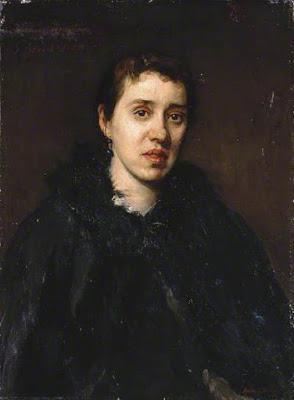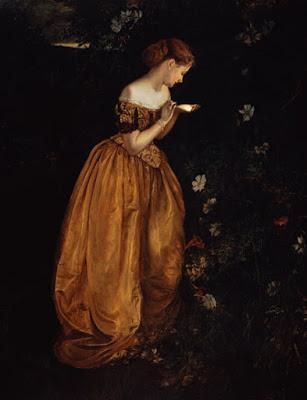
The Letter (1900-1920) Annie Louisa Swynnerton
Gorgeous! Someone asked me if she had really only lived 20 years, but that is the date range of the picture (to add to the confusion it was actually shown at the Royal Academy posthumously in 1934). Annie in fact lived a long and happy life and I'll try and do her justice here...Annie Louisa Robinson was born 26th February 1844 in a central area of Manchester. Her birth place is often given as Hulme, but within a few years her parents seemed to have moved to Chorlton-on-Medlock and then Greenheys. Her father, Francis (1815-1889) was a solicitor and the family seemed to have been Methodists, attending the non-conformist chapels in the area. It might have been in her childhood that Annie met the non-conformist minister William Gaskell, husband of the author Mrs Gaskell, who she painted in 1879.

William Gaskell (1879)
Of the six Robinson daughters, at least three of them worked as artists. Annie and her sisters Emily and Julia were all artists and all founder members of the Manchester Society of Women Painters, which I'll come to in a minute. One of the other sisters, Adela, married an artist engraver called John Brownlie, so it seems that artistic matters were valued in the Robinson household, enough to influence the life-choices of the sisters.
The Dreamer (1887)
According to The Women's Suffrage Movement: A Reference Guide 1866-1928, during a period of financial difficulty, Annie started to sell her watercolours for money, but judging by the course of Annie's life over the following years, either the period was short or her painting sales were extraordinary successful. After attending the Manchester School of Art from 1871, where she won a gold prize and a scholarship for an oil and watercolour painting, she moved to Rome to study. Annie stayed in Rome with fellow Manchester artist Susan Isabel Dacre (known as Isabel) from 1874 to 1876 after which the pair moved to Paris where they studied at the Academie Julien. A portrait of Isabel dating from this time was given by the sitter to Manchester Art Gallery in 1932...
(Susan) Isabel Dacre (1880)
On their return from Paris, Annie and Isabel, together with other local artists formed the Society of Women Painters to provide a place and facilities for the members to work together and study from life. Apparently in those days you had to leave Manchester to see a naked man. Anyway, the Society saw it as their duty to disseminate the principles of true art among the students of the art schools. They had rooms in Barton House, Deansgate where classes were held in elementary drawing, drawing from the antique and drawing and painting from living models. Isabel Dacre was the president, Annie served as secretary, her sister Emily was treasurer and other members included E Gertrude Thomson, Eleanor S Wood, Jane Atkinson and Julia Pollitt (nee Robinson, Annie and Emily's sister). The Society held annual exhibitions which were described in the local press as 'one of the most pleasing events in the artistic year in Manchester.'
Tryst or A Salford Lass (1880)
In 1880 Annie exhibited The Tryst, described in the press as a remarkable picture. It was immediately bought by Henry Boddington jnr (of the brewing family) who gave it to the Salford art gallery. Interestingly, I couldn't find too much information on the artistic career of her sisters, but whereas Annie's work received praise in every instance I found it mentioned, very little is ever said about either Emily or Julia. One of the few mentions I found was in the 1880 review in the Manchester papers describing Emily's picture Scene from Esmond as not accurate to the source material, although it did not elaborate what the problems were.
Joseph Swynnerton
Whilst in Rome, Miss Dacre and Miss Robinson made the acquaintance of Joseph Swynnerton, sculptor. Swynnerton had been attending art school, the Academy of St Luke, since 1869. In the 1882 Manchester Society of Women Painters exhibition, Isabel exhibited a three-quarter length portrait of Swynnerton. In the summer of 1883, Annie and Swynnerton married and returned to Rome where they lived until the year of his death, 1910. The couple do not seemed to have stayed exclusively in Italy, however, and Annie's career continued steadily back in England. In 1883 she showed various paintings in exhibitions, including Oleander, described in the press as 'a perfect gem'...
Oleander (1883)
During this period both Annie and Isabel Dacre became active in the suffrage campaign. In 1889, Annie signed the Declaration in favour of women's suffrage and in 1897 she signed the claim for women's suffrage. During this period she also continued to catch the eye of reviewers, her paintings traveling world wide. Her painting Florence Nightingale at Scutari was sent over to the Women's Exhibition in Chicago in 1893, as well as regularly exhibiting in the Royal Academy exhibitions and the Royal Scottish Academy, as well as the Royal Glasgow Institute, continuing her work with the Society of Women Artists and many others. In 1895, Annie was only the second woman ever invited to sit upon the hanging committee of the Liverpool Autumn Exhibition.
Cupid and Psyche (1890)
One of her most famous paintings, Cupid and Psyche, was first exhibited at the Walker Gallery in 1891. It was described in the local papers as robust, showing thorough and straightforward workmanship: 'the work shows such research of plastic beauty, the drawing so firm, the head and limbs so well modelled, that they give one the idea of being the work of a sculptor.' It might be that the reviewer is hinting at the influence of her husband, but even today the unruly curve of the wings and awkward beauty of the pair still captures the imagination.
The Glow Worm
Annie was influenced and supported by G F Watts and Edward Burne-Jones, and she tackled figurative and allegorical subjects. I find her style clearer and less impressionistic than Watts but his influence can be clearly seen in works such as Mater Triumphalis...
Mater Triumphalis (1892)
The Edwardian period brought more success and after her husband's death in 1910, Annie seems to have lived more in London than abroad. Her painting Oreads of 1907 was acquired by John Singer Sargent, a great admirer of her work and he helped her to become the first elected ARA (Angelica Kauffman and Mary Moser being founder members) in 1922. Annie also headed the section of Chelsea artists in the coronation procession of George V in 1911, organised by the women's suffrage societies.
The Sense of Sight (1895)
The picture that seems to have secured her place in the halls of the greats is The Sense of Sight, a painting showing an angel who has found heaven on earth in everything she sees (possibly as a reflection of how Annie felt in her role as a visual artist). In his 1905 book Women Painters of the World, Walter Shaw Sparrow reproduced the picture in monochrome (red).
Mrs Florence H Musgrave
Annie appeared in reviews of the Royal Academy and other exhibitions after the First World War, usually in unreservedly approving terms. In a 1929 exhibition of Aberdeen Artists' Society, one reviewer noted - 'Among the strangers (ie the non-Scots)... we liked better the work of Cadell, David Foggie and Annie Swynnerton.'
New Risen Hope
In the wonderfully disappointed review of the 1924 Royal Academy exhibition in the Western Daily Press, entitled 'Not Exactly Brilliant', the reviewer praised the painting New Risen Hope, which had been selected to be purchased for the nation via the Chantry Bequest, one of three of her works that would be purchased in her lifetime.
Dame Millicent Fawcett (1930)
Another to be purchased, in 1930, was her portrait of feminist and suffragist Millicent Fawcett, which was described in the art press as 'full of character and as fine a piece of color as anything in the exhibition.' Laura Knight, the next woman artist to become ARA after Annie, met Annie in her old age and remembered her as a formidable and eccentric woman who had done much for the status of women artists. Gladys Storey in her book Dickens and Daughter (1939) remembered Annie a little less euphemistically: 'She was a talented artist and an accomplished woman, though scarcely one of whom it could be said she possessed a charm of matter. Indeed, by maintaining the courage of her convictions she was at times embarrassingly outspoken.'
The artist at her easel
Annie's eyesight failed her in old age. She moved down to a house called 'Sicilia' in South Hayling on the south coast of England in 1930, preferring the air and sunshine to her London home. She died there on 24 October 1934, leaving a studio full of 170 pictures, all but 12 of them unfinished and unframed. When this collection was sold the following year they made £601 which is just short of £40,000 in today's money.
Annie Swynnerton's Grave, St Mary's Church, South Hayling
To conclude, I always like to find a way to bring my research home to me and with Annie it was fairly straightforward. Last Tuesday my daughter and I drove along the coast to Hayling Island and found Annie's grave. In the quiet graveyard, overlooked by a 'Light of the World' stained glass window, is Annie Swynnerton's grave, marked by a large plain stone. The inscription reads'I have known love and the light of the sun.' What more can you ask for?

